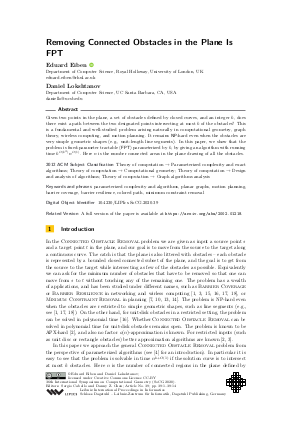Removing Connected Obstacles in the Plane Is FPT
Authors
Eduard Eiben  ,
Daniel Lokshtanov
,
Daniel Lokshtanov
-
Part of:
Volume:
36th International Symposium on Computational Geometry (SoCG 2020)
Part of: Series: Leibniz International Proceedings in Informatics (LIPIcs)
Part of: Conference: Symposium on Computational Geometry (SoCG) - License:
 Creative Commons Attribution 3.0 Unported license
Creative Commons Attribution 3.0 Unported license
- Publication Date: 2020-06-08
File

PDF
LIPIcs.SoCG.2020.39.pdf
- Filesize: 0.85 MB
- 14 pages
Document Identifiers
Related Versions
-
A full version of the paper is available at https://arxiv.org/abs/2002.01218.
Subject Classification
ACM Subject Classification
- Theory of computation → Parameterized complexity and exact algorithms
- Theory of computation → Computational geometry
- Theory of computation → Design and analysis of algorithms
- Theory of computation → Graph algorithms analysis
Keywords
- parameterized complexity and algorithms
- planar graphs
- motion planning
- barrier coverage
- barrier resilience
- colored path
- minimum constraint removal
Metrics
- Access Statistics
-
Total Accesses (updated on a weekly basis)
0Document
0Metadata
Abstract
Given two points in the plane, a set of obstacles defined by closed curves, and an integer k, does there exist a path between the two designated points intersecting at most k of the obstacles? This is a fundamental and well-studied problem arising naturally in computational geometry, graph theory, wireless computing, and motion planning. It remains NP-hard even when the obstacles are very simple geometric shapes (e.g., unit-length line segments). In this paper, we show that the problem is fixed-parameter tractable (FPT) parameterized by k, by giving an algorithm with running time k^O(k³) n^O(1). Here n is the number connected areas in the plane drawing of all the obstacles.
Cite As Get BibTex
Eduard Eiben and Daniel Lokshtanov. Removing Connected Obstacles in the Plane Is FPT. In 36th International Symposium on Computational Geometry (SoCG 2020). Leibniz International Proceedings in Informatics (LIPIcs), Volume 164, pp. 39:1-39:14, Schloss Dagstuhl – Leibniz-Zentrum für Informatik (2020)
https://doi.org/10.4230/LIPIcs.SoCG.2020.39
BibTex
@InProceedings{eiben_et_al:LIPIcs.SoCG.2020.39,
author = {Eiben, Eduard and Lokshtanov, Daniel},
title = {{Removing Connected Obstacles in the Plane Is FPT}},
booktitle = {36th International Symposium on Computational Geometry (SoCG 2020)},
pages = {39:1--39:14},
series = {Leibniz International Proceedings in Informatics (LIPIcs)},
ISBN = {978-3-95977-143-6},
ISSN = {1868-8969},
year = {2020},
volume = {164},
editor = {Cabello, Sergio and Chen, Danny Z.},
publisher = {Schloss Dagstuhl -- Leibniz-Zentrum f{\"u}r Informatik},
address = {Dagstuhl, Germany},
URL = {https://drops.dagstuhl.de/entities/document/10.4230/LIPIcs.SoCG.2020.39},
URN = {urn:nbn:de:0030-drops-121972},
doi = {10.4230/LIPIcs.SoCG.2020.39},
annote = {Keywords: parameterized complexity and algorithms, planar graphs, motion planning, barrier coverage, barrier resilience, colored path, minimum constraint removal}
}
Author Details
References
-
H. Alt, S. Cabello, P. Giannopoulos, and C. Knauer. Minimum cell connection in line segment arrangements. International Journal of Computational Geometry and Applications, 27(3):159-176, 2017.

-
Sayan Bandyapadhyay, Neeraj Kumar, Subhash Suri, and Kasturi R. Varadarajan. Improved approximation bounds for the minimum constraint removal problem. In Approximation, Randomization, and Combinatorial Optimization. Algorithms and Techniques, APPROX/RANDOM 2018, August 20-22, 2018 - Princeton, NJ, USA, pages 2:1-2:19, 2018.

-
S. Bereg and D. Kirkpatrick. Approximating barrier resilience in wireless sensor networks. In Proceedings of ALGOSENSORS, pages 29-40, 2009.

-
Marek Cygan, Fedor V. Fomin, Lukasz Kowalik, Daniel Lokshtanov, Dániel Marx, Marcin Pilipczuk, Michal Pilipczuk, and Saket Saurabh. Parameterized Algorithms. Springer, 2015.

-
Reinhard Diestel. Graph Theory, 4th Edition, volume 173 of Graduate texts in mathematics. Springer, 2012.

-
Rodney G. Downey and Michael R. Fellows. Fundamentals of Parameterized Complexity. Texts in Computer Science. Springer, 2013.

-
Eduard Eiben, Jonathan Gemmell, Iyad A. Kanj, and Andrew Youngdahl. Improved results for minimum constraint removal. In Sheila A. McIlraith and Kilian Q. Weinberger, editors, Proceedings of the Thirty-Second AAAI Conference on Artificial Intelligence, (AAAI-18), the 30th innovative Applications of Artificial Intelligence (IAAI-18), and the 8th AAAI Symposium on Educational Advances in Artificial Intelligence (EAAI-18), New Orleans, Louisiana, USA, February 2-7, 2018, pages 6477-6484. AAAI Press, 2018.

- Eduard Eiben and Iyad A. Kanj. How to navigate through obstacles? In Ioannis Chatzigiannakis, Christos Kaklamanis, Dániel Marx, and Donald Sannella, editors, 45th International Colloquium on Automata, Languages, and Programming, ICALP 2018, July 9-13, 2018, Prague, Czech Republic, volume 107 of LIPIcs, pages 48:1-48:13. Schloss Dagstuhl - Leibniz-Zentrum fuer Informatik, 2018. Full version avaiable at URL: https://arxiv.org/abs/1712.04043v1.
-
Paul Erdös and Richard Rado. Intersection theorems for systems of sets. Journal of the London Mathematical Society, 1(1):85-90, 1960.

-
L. Erickson and S. LaValle. A simple, but NP-hard, motion planning problem. In Proceedings of AAAI. AAAI Press, 2013.

-
Jörg Flum and Martin Grohe. Parameterized Complexity Theory, volume XIV of Texts in Theoretical Computer Science. An EATCS Series. Springer, Berlin, 2006.

-
Fedor V. Fomin, Daniel Lokshtanov, Fahad Panolan, and Saket Saurabh. Efficient computation of representative families with applications in parameterized and exact algorithms. J. ACM, 63(4):29:1-29:60, 2016.

-
A. Gorbenko and V. Popov. The discrete minimum constraint removal motion planning problem. In Proceedings of the American Institute of Physics, volume 1648. AIP Press, 2015.

-
K. Hauser. The minimum constraint removal problem with three robotics applications. International Journal of Robotics Research, 33(1):5-17, 2014.

-
M. Korman, M. Löffler, R. Silveira, and D. Strash. On the complexity of barrier resilience for fat regions and bounded ply. Computational Geometry, 72:34-51, 2018.

-
S. Kumar, T. Lai, and A. Arora. Barrier coverage with wireless sensors. Wireless Networks, 13(6):817-834, 2007.

-
K. Tseng and D. Kirkpatrick. On barrier resilience of sensor networks. In Proceedings of ALGOSENSORS, pages 130-144, 2012.

-
S. Yang. Some Path Planning Algorithms in Computational Geometry and Air Traffic Management. PhD thesis, University of New Yort at Stony Brook. Available at: https://dspace.sunyconnect.suny.edu/handle/1951/59927, 2012.

